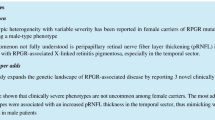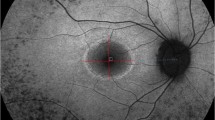Abstract
Background
Diurnal variations in foveal thickness have been reported in several ocular pathologies including X-linked retinoschisis (XLRS), but its underlying mechanism is poorly understood. Rods are active under scotopic conditions with high metabolic demand, and its decrease may have positive effect on metabolic activity and macular thickness. The purpose of this study is to evaluate whether exposure to light and diurnal variation influence macular thickness in XLRS patients.
Methods
Five patients with clinical suspicion of XLRS underwent RS1 gene sequencing and optical coherence tomography measurements at three consecutive times: morning following sleep in a dark room, morning following sleep in an illuminated room, and late afternoon following sleep in an illuminated room. Central macular thickness (CMT) was compared between measurements, and molecular analysis was performed.
Results
Five RS1 mutations were identified: p.Gly140Arg, p.Arg141Cys, p.Gly109Glu, p.Pro193Leu, and p.Arg200His in patients 1–5, respectively. Two patients (4–5) had atrophied macula and were excluded from macular thickness variation analysis. A significant decrease in CMT between morning and afternoon measurements was observed in all patients (1–3: mean: 455.0 ± 32 μm to 342.17 ± 39 μm, 25%). Morning measurements following sleep in an illuminated room show a CMT reduction in all eyes of all patients with a mean reduction of 113 μm (mean: 547.17 ± 105 μm to 455.0 ± 32 μm, 17%).
Conclusions
Among XLRS patients, CMT decreased at the afternoon compared to the morning of the same day and may be reduced following sleep in an illuminated room. These results help shed light on the pathophysiologic process underlying intraretinal fluid accumulation involved with the disease.





Similar content being viewed by others
References
Tantri A, Vrabec TR, Cu-Unjieng A, Frost A, Annesley WH Jr, Donoso LA (2004) X-linked retinoschisis: a clinical and molecular genetic review. Surv Ophthalmol 49(2):214–230
Gurbaxani A, Wei M, Succar T, McCluskey PJ, Jamieson RV, Grigg JR (2014) Acetazolamide in retinoschisis: a prospective study. Ophthalmology 121(3):802–3.e3
Bush RA, Wei LL, Sieving PA (2015) Convergence of human genetics and animal studies: gene therapy for X-linked retinoschisis. Cold Spring Harb Perspect Med 5(8):a017368
Paques M, Massin P, Sahel JA, Gaudric A, Bergmann J-F, Azancot S et al (2005) Circadian fluctuations of macular edema in patients with morning vision blurring: correlation with arterial pressure and effect of light deprivation. Invest Ophthalmol Vis Sci 46(12):4707–4711
Gupta B, Grewal J, Adewoyin T, Pelosini L, Williamson TH (2009) Diurnal variation of macular oedema in CRVO: prospective study. Graefes Arch Clin Exp Ophthalmol 247(5):593–596
Polito A, Polini G, Chiodini RG, Isola M, Soldano F, Bandello F (2007) Effect of posture on the diurnal variation in clinically significant diabetic macular edema. Invest Ophthalmol Vis Sci 48(7):3318–3323
Larsen M, Wang M, Sander B (2005) Overnight thickness variation in diabetic macular edema. Invest Ophthalmol Vis Sci 46(7):2313–2316
Frank RN, Schulz L, Abe K, Iezzi R (2004) Temporal variation in diabetic macular edema measured by optical coherence tomography. Ophthalmology. 111(2):211–217
Abalem MF, Musch DC, Birch DG, Pennesi ME, Heckenlively JR, Jayasundera T (2018) Diurnal variations of foveoschisis by optical coherence tomography in patients with RS1 X-linked juvenile retinoschisis. Ophthalmic Genet 39(4):437–442
Okawa H, Sampath AP, Laughlin SB, Fain GL (2008) ATP consumption by mammalian rod photoreceptors in darkness and in light. Curr Biol 18(24):1917–1921
Arden GB, Sidman RL, Arap W, Schlingemann RO (2005) Spare the rod and spoil the eye. Br J Ophthalmol 89(6):764–769
The Israel Meteorological Service (IMS), Ministry of Transport, State of Israel. Available from: http://www.ims.gov.il/.
Lanca C, Teo A, Vivagandan A, Htoon HM, Najjar RP, Spiegel DP et al (2019) The effects of different outdoor environments, sunglasses and hats on light levels: implications for myopia prevention. Transl Vis Sci Technol 8(4):7
The Retinoschisis Consortium (1998) Functional implications of the spectrum of mutations found in 234 cases with X-linked juvenile retinoschisis. Hum Mol Genet 7(7):1185–1192
Mashima Y, Shinoda K, Ishida S, Ozawa Y, Kudoh J, Iwata T et al (1999) Identification of four novel mutations of the XLRS1 gene in Japanese patients with X-linked juvenile retinoschisis. Mutation in brief no. 234. Online. Hum Mutat 13(4):338
Sauer CG, Gehrig A, Warneke-Wittstock R, Marquardt A, Ewing CC, Gibson A et al (1997) Positional cloning of the gene associated with X-linked juvenile retinoschisis. Nat Genet 17(2):164–170
Kurtenbach A, Mayser HM, Jagle H, Fritsche A, Zrenner E (2006) Hyperoxia, hyperglycemia, and photoreceptor sensitivity in normal and diabetic subjects. Vis Neurosci 23(3–4):651–661
Nguyen QD, Shah SM, Van Anden E, Sung JU, Vitale S, Campochiaro PA (2004) Supplemental oxygen improves diabetic macular edema: a pilot study. Invest Ophthalmol Vis Sci 45(2):617–624
Arden GB, Gunduz MK, Kurtenbach A, Volker M, Zrenner E, Gunduz SB et al (2010) A preliminary trial to determine whether prevention of dark adaptation affects the course of early diabetic retinopathy. Eye (Lond) 24(7):1149–1155
Arden GB, Jyothi S, Hogg CH, Lee YF, Sivaprasad S (2011) Regression of early diabetic macular oedema is associated with prevention of dark adaptation. Eye (Lond) 25(12):1546–1554
Sivaprasad S, Arden G, Prevost AT, Crosby-Nwaobi R, Holmes H, Kelly J et al (2014) A multicentre phase III randomised controlled single-masked clinical trial evaluating the clinical efficacy and safety of light-masks at preventing dark-adaptation in the treatment of early diabetic macular oedema (CLEOPATRA): study protocol for a randomised controlled trial. Trials 15:458
Arden GB (2001) The absence of diabetic retinopathy in patients with retinitis pigmentosa: implications for pathophysiology and possible treatment. Br J Ophthalmol 85(3):366–370
Wesolowski E, Smith LE (1994) Effect of light on oxygen-induced retinopathy in the mouse. Invest Ophthalmol Vis Sci 35(1):112–119
Zylbermann R, Landau D, Rozenman Y, Abrahami S, Pollack A (1997) Exudative age-related macular degeneration in patients with diabetic retinopathy and its relation to retinal laser photocoagulation. Eye (Lond) 11(Pt 6):872–875
Funding
This study was supported by the Claire and Amedee Maratier Institute for the Study of Blindness and Visual Disorders; The Hirsh and Genia Wasserman, The Medical Research Fund and Ernest And Nusia Gothelf research funds, Sackler Faculty of Medicine, Tel-Aviv University, Tel-Aviv, Israel. This work was also supported in part by grant no. 7205 from the Chief Scientist Office of the Ministry of Health, Israel; “Lirot” Association and the Consortium for Mapping Retinal Degeneration Disorders in Israel.
Author information
Authors and Affiliations
Corresponding author
Ethics declarations
Conflict of interest
All authors declare that they have no conflict of interest.
Ethical approval
All procedures performed in studies involving human participants were in accordance with the ethical standards of the Shamir Medical Center Research committee and with the 1964 Helsinki declaration and its later amendments or comparable ethical standards.
Informed consent
Informed consent was obtained from all individual participants included in the study.
Additional information
Publisher’s note
Springer Nature remains neutral with regard to jurisdictional claims in published maps and institutional affiliations.
Rights and permissions
About this article
Cite this article
Rubinstein, Y., Weiner, C., Chetrit, N. et al. Effect of light and diurnal variation on macular thickness in X-linked retinoschisis: a case series. Graefes Arch Clin Exp Ophthalmol 258, 529–536 (2020). https://doi.org/10.1007/s00417-019-04578-7
Received:
Revised:
Accepted:
Published:
Issue Date:
DOI: https://doi.org/10.1007/s00417-019-04578-7




